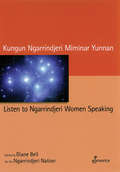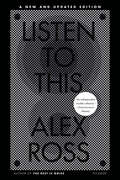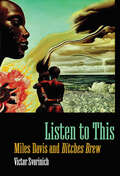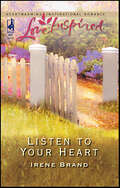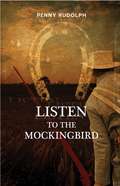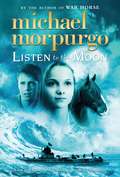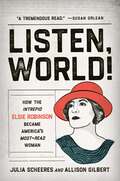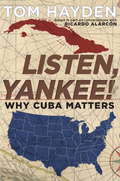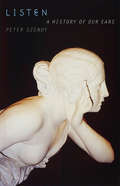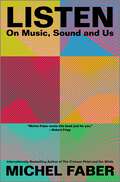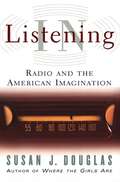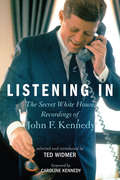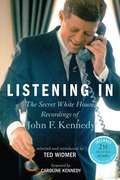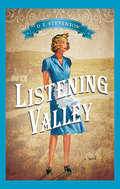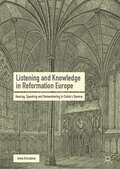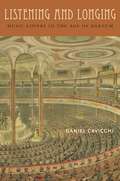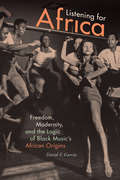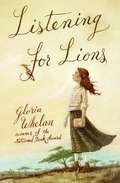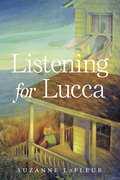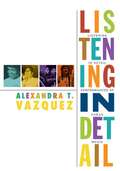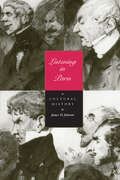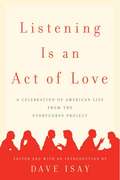- Table View
- List View
Listen to Ngarrindjeri Women Speaking: Kungun Ngarrindjeri Miminar Yunnan
by Diane BellThe Ngarridjeri women of South Australia reveal their thoughts, daily challenges, and visions for the future in this moving book. The stories range from charming and delightful to jarring and shocking, and delve into matters both social and personal--including the Hindmarsh Island bridge controversy. Serving as a model for how indigenous and nonindigenous women can jointly write a book, this narrative can help indigenous women in other communities develop their own collective history and visions for the future.
Listen to This
by Alex RossOne of The Telegraph's Best Music Books 2011 Alex Ross's award-winning international bestseller, The Rest Is Noise: Listening to the Twentieth Century, has become a contemporary classic, establishing Ross as one of our most popular and acclaimed cultural historians. Listen to This, which takes its title from a beloved 2004 essay in which Ross describes his late-blooming discovery of pop music, showcases the best of his writing from more than a decade at The New Yorker. These pieces, dedicated to classical and popular artists alike, are at once erudite and lively. In a previously unpublished essay, Ross brilliantly retells hundreds of years of music history—from Renaissance dances to Led Zeppelin—through a few iconic bass lines of celebration and lament. He vibrantly sketches canonical composers such as Schubert, Verdi, and Brahms; gives us in-depth interviews with modern pop masters such as Björk and Radiohead; and introduces us to music students at a Newark high school and indie-rock hipsters in Beijing.Whether his subject is Mozart or Bob Dylan, Ross shows how music expresses the full complexity of the human condition. Witty, passionate, and brimming with insight, Listen to This teaches us how to listen more closely.
Listen to This: Miles Davis and Bitches Brew (American Made Music Series)
by Victor SvorinichListen to This stands out as the first book exclusively dedicated to Davis's watershed 1969 album, Bitches Brew. Victor Svorinich traces its incarnations and inspirations for ten-plus years before its release. The album arrived as the jazz scene waned beneath the rise of rock-and-roll and as Davis (1926–1991) faced large changes in social conditions affecting the African American consciousness. This new climate served as a catalyst for an experiment that many considered a major departure. Davis's new music projected rock-and-roll sensibilities, the experimental essence of 1960s' counterculture, yet also harsh dissonances of African American reality. Many listeners embraced it, while others misunderstood and rejected the concoction. Listen to This is not just the story of Bitches Brew. It reveals much of the legend of Miles Davis—his attitude and will, his grace under pressure, his bands, his relationship to the masses, his business and personal etiquette, and his response to extraordinary social conditions seemingly aligned to bring him down. Svorinich revisits the mystery and skepticism surrounding the album and places it into both a historical and musical context using new interviews, original analysis, recently found recordings, unearthed session data sheets, memoranda, letters, musical transcriptions, scores, and a wealth of other material. Additionally, Listen to This encompasses a thorough examination of producer Teo Macero's archives and Bitches Brew's original session reels in order to provide the only complete day-to-day account of the sessions.
Listen to Your Heart
by Irene BrandLaurel Cooper was too busy planning her only daughter’s wedding to make time for romance. But the fortysomething widow couldn’t ignore the rugged photojournalist who’d appeared on her doorstep to photograph her antebellum home-turned-boarding house. Especially not when they spent so much time together as she gave him tours of other local historic homes. Micah Davidson made himself indispensable, even covering the wedding as a favor for his lovely new landlady. Yet just as Micah was about to propose, a shocking photograph surfaced, turning Laurel’s world upside down. Could their love outlast the long-buried secrets from Laurel’s past?
Listen to the Mockingbird
by Penny RudolphIt's 1861 in New Mexico Territory, and the Civil War is about to have a startling impact on Matty Summerhayes. Matty is struggling to develop a horse ranch to make enough money to return to the East. A stranger dies in her barn...with a map of her land in his pocket. Then war is declared, and Texans invade her valley for the Confederacy. Rumors begin to fly about a lost gold mine and soon someone is trying to run her off her ranch. Then her closest friend Winona -- a one-time slave who is now nearing childbirth -- is about to be stoned for practicing voodoo, and only Matty's creative quick thinking can save her. But when Matty's greatest secret is exposed, she must find a killer or lose her ranch.
Listen to the Moon
by Michael MorpurgoAlfie and his father find a lost girl in an abandoned house on a small island. The girl doesn't speak, except to say what sounds like "Lucy." Alfie's mother nurses her back to health. <P><P>The others in the village suspect the unthinkable: Lucy is actually German--an enemy--because she's found with a blanket with a German tag. <P><P>Told from Alfie and Merry's points of view, this exquisite novel tells of friends, enemies, and unexpected kindnesses.
Listen, Vienna: The Life of St. Clement Mary Hofbauer
by James J. GalvinIn many ways this book gives an old history of Germany, France,and Russia during the 18th century. It is a story of deep commitment, lasting faith, and the resilience of the spirit in times of great oppression.
Listen, World!: How the Intrepid Elsie Robinson Became America's Most-Read Woman
by Julia Scheeres Allison Gilbert*Winner of the 2023 Northern California Book Award* The first biography of Elsie Robinson, the most influential newspaper columnist you&’ve never heard of At thirty-five, Elsie Robinson feared she&’d lost it all. Reeling from a scandalous divorce in 1917, she had no means to support herself and her chronically ill son. She dreamed of becoming a writer and was willing to sacrifice everything for this goal, even swinging a pickax in a gold mine to pay the bills. When the mine shut down, she moved to the Bay Area. Armed with moxie and samples of her work, she barged into the offices of the Oakland Tribune and was hired on the spot. She went on to become a nationally syndicated columnist and household name whose column ran for over thirty years and garnered more than twenty million readers. Told in cinematic detail by bestselling author Julia Scheeres and award-winning journalist Allison Gilbert, Listen, World! is the inspiring story of a timeless maverick, capturing what it means to take a gamble on self-fulfillment and find freedom along the way.
Listen, Yankee!
by Tom HaydenBased on unprecedented access to both Cuban and American officials, a book that offers fresh insight into one of history's most enigmatic relationships between nation-states--from one of America's best-known voices of political and social activism.Listen, Yankee! offers an account of Cuban politics from Tom Hayden's unique position as an observer of Cuba and as a US revolutionary student leader whose efforts to mobilize political change in the US mirrored the radical transformation simultaneously going on in Cuba.Chapters are devoted to the writings of Che Guevara, Régis Debray, and C. Wright Mills; the Cuban missile crisis; the Weather Underground; the assassination of JFK; the strong historical links between Cuba and Africa; the Carter era; the Clinton era; the Cuban Five; Elián González; and the December 17, 2014 declaration of normalization by presidents Obama and Castro.Hayden puts the present moment into historical context, and shows how we're finally finding common ground to the advantage of Cubans and Americans alike. From the Hardcover edition.
Listen: A History of Our Ears
by Charlotte Mandell Jean-Luc Nancy Peter SzendyIn this intimate meditation on listening, Peter Szendy examines what the role of the listener is, and has been, through the centuries. The role of the composer is clear, as is the role of the musician, but where exactly does the listener stand in relation to the music s/he listens to? What is the responsibility of the listener? Does a listener have any rights, as the author and composer have copyright? Szendy explains his love of musical arrangement (since arrangements allow him to listen to someone listening to music), and wonders whether it is possible in other ways to convey to others how we ourselves listen to music. How can we share our actual hearing with others? Along the way, he examines the evolution of copyright laws as applied to musical works and takes us into the courtroom to examine different debates on what we are and aren’t allowed to listen to, and to witness the fine line between musical borrowing and outright plagiarism. Finally, he examines the recent phenomenon of DJs and digital compilations, and wonders how technology has affected our habits of listening and has changed listening from a passive exercise to an active one, whereby one can jump from track to track or play only selected pieces.
Listen: On Music, Sound and Us
by Michel Faber"I'm not here to change your mind about Dusty Springfield or Shostakovich or Tupac Shakur or synthpop. I'm here to change your mind about your mind." There are countless books on music with much analysis given to musicians, bands, eras and/or genres. But rarely does a book delve into what's going on inside us when we listen.Michel Faber explores two big questions: how do we listen to music and why do we listen to music? To answer these questions, he considers a range of factors, which includes age, illness, the notion of "cool," commerce, the dichotomy between "good" and "bad" taste and much more. From the award-winning author of The Crimson Petal and the White and Under the Skin, this idiosyncratic and philosophical book reflects Michel Faber's lifelong obsession with music of all kinds. Listen will change your relationship with the heard world.
Listening In: Radio and the American Imagination
by Susan J. DouglasFew inventions evoke such nostalgia, such deeply personal and vivid memories as radio—from Amos &’n&’ Andy and Edward R. Murrow to Wolfman Jack and Howard Stern. Listening In is the first in-depth history of how radio culture and content have kneaded and expanded the American psyche.But Listening In is more than a history. It is also a reconsideration of what listening to radio has done to American culture in the twentieth century and how it has brought a completely new auditory dimension to our lives. Susan Douglas explores how listening has altered our day-to-day experiences and our own generational identities, cultivating different modes of listening in different eras; how radio has shaped our views of race, gender roles, ethnic barriers, family dynamics, leadership, and the generation gap. With her trademark wit, Douglas has created an eminently readable cultural history of radio.
Listening In: The Secret White House Recordings of John F. Kennedy
by Caroline Kennedy Ted WidmerIn July 1962, in an effort to preserve an accurate record of Presidential decision-making in a highly charged atmosphere of conflicting viewpoints, strategies and tactics, John F. Kennedy installed hidden recording systems in the Oval Office and in the Cabinet Room. The result is a priceless historical archive comprising some 265 hours of taped material. JFK was elected president when Civil Rights tensions were near the boiling point, and Americans feared a nuclear war. Confronted with complex dilemmas necessitating swift and unprecedented action, President Kennedy engaged in intense discussion and debate with his cabinet members and other advisors. Now, in conjunction with the fiftieth anniversary of the Kennedy presidency, the John F. Kennedy Library and historian Ted Widmer have carefully selected the most compelling and important of these remarkable recordings for release, fully restored and re-mastered onto two 75-minute CDs for the first time. Listening In represents a uniquely unscripted, insider account of a president and his cabinet grappling with the day-to-day business of the White House and guiding the nation through a hazardous era of uncertainty.Accompanied by extensively annotated transcripts of the recordings, and with a foreword by Caroline Kennedy, Listening In delivers the story behind the story in the unguarded words and voices of the decision-makers themselves. Listening In covers watershed events, including the Cuban Missile Crisis, the Space Race, Vietnam, and the arms race, and offers fascinating glimpses into the intellectual methodology of a circumspect president and his brilliant, eclectic brain trust. Just as the unique vision of President John F. Kennedy continues to resonate half a century after his stirring speeches and bold policy decisions, the documentary candor of Listening In imparts a vivid, breathtaking immediacy that will significantly expand our understanding of his time in office.
Listening In: The Secret White House Recordings of John F. Kennedy
by Ted WidmerIn July 1962, in an effort to preserve an accurate record of Presidential decision-making in a highly charged atmosphere of conflicting viewpoints, strategies and tactics, John F. Kennedy installed hidden recording systems in the Oval Office and in the Cabinet Room. The result is a priceless historical archive comprising some 265 hours of taped material. JFK was elected president when Civil Rights tensions were near the boiling point, and Americans feared a nuclear war. Confronted with complex dilemmas necessitating swift and unprecedented action, President Kennedy engaged in intense discussion and debate with his cabinet members and other advisors. Now, in conjunction with the fiftieth anniversary of the Kennedy presidency, the John F. Kennedy Library and historian Ted Widmer have carefully selected the most compelling and important of these remarkable recordings for release, fully restored and re-mastered onto two 75-minute CDs for the first time. Listening In represents a uniquely unscripted, insider account of a president and his cabinet grappling with the day-to-day business of the White House and guiding the nation through a hazardous era of uncertainty. Accompanied by extensively annotated transcripts of the recordings, and with a foreword by Caroline Kennedy, Listening In delivers the story behind the story in the unguarded words and voices of the decision-makers themselves. Listening In covers watershed events, including the Cuban Missile Crisis, the Space Race, Vietnam, and the arms race, and offers fascinating glimpses into the intellectual methodology of a circumspect president and his brilliant, eclectic brain trust. Just as the unique vision of President John F. Kennedy continues to resonate half a century after his stirring speeches and bold policy decisions, the documentary candor of Listening In imparts a vivid, breathtaking immediacy that will significantly expand our understanding of his time in office.
Listening Valley
by D. E. StevensonNothing will stop Tonia from finding a home of her ownTonia has lived all her life in the quiet Scottish countryside and can't imagine herself anywhere else. But when her beloved older sister gets married and moves away, Tonia begins to wonder if there aren't bigger things on the horizon for her too.The advent of World War II brings Tonia briefly to the heart of London, where the roar of fighter planes echoes through the night and bombings are a constant threat--but just as she's settling into her new life, a heart-breaking tragedy sends her back home to Scotland. With new friends by her side, Tonia thinks she may have finally found the place where she is supposed to be. But the war interferes again with her plans, and she fears that the person she loves most may be lost to her forever.Readers Love D.E. Stevenson's Books:"This heartwarming novel is the literary equivalent of a comforting cup of cocoa on a cozy winter's evening--I can't recommend it highly enough."
Listening and Knowledge in Reformation Europe: Hearing, Speaking and Remembering in Calvin’s Geneva
by Anna KvicalovaThis book investigates a host of primary sources documenting the Calvinist Reformation in Geneva, exploring the history and epistemology of religious listening at the crossroads of sensory anthropology and religion, knowledge, and media. It reconstructs the social, religious, and material relations at the heart of the Genevan Reformation by examining various facets of the city’s auditory culture which was marked by a gradual fashioning of new techniques of listening, speaking, and remembering. Anna Kvicalova analyzes the performativity of sensory perception in the framework of Calvinist religious epistemology, and approaches hearing and acoustics both as tools through which the Calvinist religious identity was constructed, and as objects of knowledge and rudimentary investigation. The heightened interest in the auditory dimension of communication observed in Geneva is studied against the backdrop of contemporary knowledge about sound and hearing in a wider European context.
Listening and Longing: Music Lovers in the Age of Barnum (Music Culture)
by Daniel CavicchiListening and Longing explores the emergence of music listening in the United States, from its early stages in the antebellum era, when entrepreneurs first packaged and sold the experience of hearing musical performance, to the Gilded Age, when genteel critics began to successfully redefine the cultural value of listening to music. In a series of interconnected stories, American studies scholar Daniel Cavicchi focuses on the impact of industrialization, urbanization, and commercialization in shaping practices of music audiences in America. Grounding our contemporary culture of listening in its seminal historical moment--before the iPod, stereo system, or phonograph--Cavicchi offers a fresh understanding of the role of listening in the history of music.
Listening for Africa: Freedom, Modernity, and the Logic of Black Music's African Origins
by David F. GarcíaIn Listening for Africa David F. Garcia explores how a diverse group of musicians, dancers, academics, and activists engaged with the idea of black music and dance’s African origins between the 1930s and 1950s. Garcia examines the work of figures ranging from Melville J. Herskovits, Katherine Dunham, and Asadata Dafora to Duke Ellington, Dámaso Pérez Prado, and others who believed that linking black music and dance with Africa and nature would help realize modernity’s promises of freedom in the face of fascism and racism in Europe and the Americas, colonialism in Africa, and the nuclear threat at the start of the Cold War. In analyzing their work, Garcia traces how such attempts to link black music and dance to Africa unintentionally reinforced the binary relationships between the West and Africa, white and black, the modern and the primitive, science and magic, and rural and urban. It was, Garcia demonstrates, modernity’s determinations of unraced, heteronormative, and productive bodies, and of scientific truth that helped defer the realization of individual and political freedom in the world.
Listening for America: Inside The Great American Songbook From Gershwin To Sondheim
by Rob Kapilow“Not since the late Leonard Bernstein has classical music had a combination salesman-teacher as irresistible as Kapilow.” —Kansas City Star Few people in recent memory have dedicated themselves as devotedly to the story of twentieth- century American music as Rob Kapilow, the composer, conductor, and host of the hit NPR music radio program, What Makes It Great? Now, in Listening for America, he turns his keen ear to the Great American Songbook, bringing many of our favorite classics to life through the songs and stories of eight of the twentieth century’s most treasured American composers—Kern, Porter, Gershwin, Arlen, Berlin, Rodgers, Bernstein, and Sondheim. Hardly confi ning himself to celebrating what makes these catchy melodies so unforgettable, Kapilow delves deeply into how issues of race, immigration, sexuality, and appropriation intertwine in masterpieces like Show Boat and West Side Story. A book not just about musical theater but about America itself, Listening for America is equally for the devotee, the singer, the music student, or for anyone intrigued by how popular music has shaped the larger culture, and promises to be the ideal gift book for years to come.
Listening for God in Torah and Creation: A weekly encounter with conscience and soul
by Jonathan Wittenberg'The essence of Jewish life is not the bland performance of the Torah's commandments, but rather love of Torah and the way of life to which it is the guide.'Tap into the wisdom of one the world's ancient religions by meditating on Rabbi Wittenberg's engaging, contemporary, spiritual, social and ethical insights to the Torah. Rooted in decades of devoted immersion in Jewish learning, humanist literature, concern for people at all ages and stages of life, environmental activism and a love of nature, Rabbi Wittenberg offers wisdom relevant to Jews, Christians and spiritual seekers of all and no faiths.Over the hundred and more passages, key issues considered include: Compassion and kindness; Creation and wonder; Emotional struggles; Environment and our relationship to nature; Ethical challenges; Illness and suffering; Identity and community; Justice and Social Justice; Refugees and strangers; Remorse and repentance; Responsibility; Searching for meaning; Seeking God.
Listening for Lions
by Gloria WhelanHistorical fiction with a wicked twist. Listening for Lions is a breathtaking story of tragedy, deception, and triumph against all odds. National Book Award-winning author Gloria Whelan sets this richly historical coming-of-age adventure in British East Africa in the year 1918. This irresistible novel entangles an orphaned girl in a deceit-filled plot. Young Rachel Sheridan is made to leave her beloved Africa for England, where she must pose as the deceased daughter of a nefarious couple in an effort to gain them an enormous inheritance. Her irrepressible spirit and extraordinary wit turn her from victim to heroine in a surprising and empowering tale of a remarkable young woman.
Listening for Lucca
by Suzanne Lafleur"I'm obsessed with abandoned things." Siena's obsession began a year and a half ago, around the time her two-year-old brother Lucca stopped talking. Now Mom and Dad are moving the family from Brooklyn to Maine hoping that it will mean a whole new start for Lucca and Siena. She soon realizes that their wonderful old house on the beach holds secrets. When Siena writes in her diary with an old pen she found in her closet, the pen writes its own story, of Sarah and Joshua, a brother and sister who lived in the same house during World War II. As the two stories unfold, amazing parallels begin to appear, and Siena senses that Sarah and Joshua's story might contain the key to unlocking Lucca's voice.
Listening in Detail: Performances of Cuban Music
by Vazquez Alexandra T.Listening in Detail is an original and impassioned take on the intellectual and sensory bounty of Cuban music as it circulates between the island, the United States, and other locations. It is also a powerful critique of efforts to define "Cuban music" for ethnographic examination or market consumption. Contending that the music is not a knowable entity but a spectrum of dynamic practices that elude definition, Alexandra T. Vazquez models a new way of writing about music and the meanings assigned to it. "Listening in detail" is a method invested in opening up, rather than pinning down, experiences of Cuban music. Critiques of imperialism, nationalism, race, and gender emerge in fragments and moments, and in gestures and sounds through Vazquez's engagement with Alfredo Rodríguez's album Cuba Linda (1996), the seventy-year career of the vocalist Graciela Pérez, the signature grunt of the "Mambo King" Dámaso Pérez Prado, Cuban music documentaries of the 1960s, and late-twentieth-century concert ephemera.
Listening in Paris: A Cultural History (Studies on the History of Society and Culture #21)
by James H. JohnsonBeginning with the simple question, "Why did audiences grow silent?" Listening in Paris gives a spectator's-eye view of opera and concert life from the Old Regime to the Romantic era, describing the transformation in musical experience from social event to profound aesthetic encounter. James H. Johnson recreates the experience of audiences during these rich decades with brio and wit. Woven into the narrative is an analysis of the political, musical, and aesthetic factors that produced more engaged listening. Johnson shows the gradual pacification of audiences from loud and unruly listeners to the attentive public we know today.Drawing from a wide range of sources—novels, memoirs, police files, personal correspondence, newspaper reviews, architectural plans, and the like—Johnson brings the performances to life: the hubbub of eighteenth-century opera, the exuberance of Revolutionary audiences, Napoleon's musical authoritarianism, the bourgeoisie's polite consideration. He singles out the music of Gluck, Haydn, Rossini, and Beethoven as especially important in forging new ways of hearing. This book's theoretical edge will appeal to cultural and intellectual historians in many fields and periods.
Listening is an Act of Love: A Celebration of American Lives from the StoryCorps Project
by Dave IsaySelection of excerpts from oral history interviews from the StoryCorps Project which are also broadcast on NPR's "Morning Edition" every Friday.
